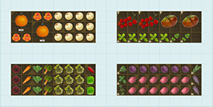You must first log in or sign up before accessing this page.
Legend
- Start Indoors
- Transplant
- Start Outdoors
- Care
- Harvest
- Succession Plant
Calendula : Datura Triple Yellow Trumpet



(Other common names: Jimson Weed, Horn of Plenty, Devil’s Trumpet, Thorn Apple). A delightful and easy to grow plant, suitable for a container or the garden! These fast growing Datura have single, white trumpet shaped blooms with lilac/purple highlights in the center. Blooms are about riple White Devil's Trumpet (datura) seeds PLUS planting instructions, including a color photo for seedling id. The mix is approximately equal number of each color, but since it is a mix, I can't guarantee the exact percentage you will get of each color. These are fresh seeds that I have planted myself with excellent germination results. They do take 21+ days for germination and need it HOT. You will be getting seeds for fragrant Datura with double purple, triple white and triple yellow blooms. The blooms face upward and the plants are a bush reaching 3 feet tall and 2-3 feet wide. If the flowers weren't enough, the double purple plants also sport glossy, dark purple stems. Datura is a perennial in zones 8 and warmer and usually lives about 4 or 5 years under good conditions. Treat as a fast growing, self-sowing annual in other areas. Datura’s produce several seed pods and thrive in high heat, particularly in humid areas. They are very rapid growing plants in full sun or partial shade. Datura’s can be started in pots or directly in the garden after last frost; they also make a wonderful container plant on patios or decks. They are easy to transplant when small, but more difficult once established in the garden. The plants/flowers/seeds are poisonous.
Asteraceae Calendula officinalis
This is an example of the timeline you would see based on your growing conditions.
Calendula: Calendula
Datura Triple Yellow Trumpet
Also known as Pot Marigold, Calendula is an annual with redish, pinkish, orangish, or yellowish creamy blooms. They add sparkle to country-style bouquets and lure visiting summer butterflies. Their edible petals make colorful salad garnishes. Flowers are used as a food color, natural dye, and substitute for saffron. The plant is a prolific self-seeder. The part used is the whole flower, either fresh or dried.
Medicinal: Traditionally used as an anti-inflammatory herb for localized skin problems including insect bites and stings. Reported to activate cellular defense mechanisms. Flowers have MANY other medicinal uses not noted here.
Basics
- Ease of Growing
- Easy
- Grown as
- Annual
- Days to Maturity
- 2-21 (Spring/Summer)
- Growing Habit
- -
- Hardiness
- Hardy
Calendulas can tolerate light frost and will sometimes survive a hard frost or snow.
- Crops
- Spring Transplant, Spring
- Growing Season
- Short, Long
- Cultivar Type
- -
- Growing Conditions
- Cool, Warm
Calendulas tolerate a wide variety of climates but will do best in full sun, well-draining rich soil, and cool temperatures. The plants will often stop blooming in hot weather.
- Outdoor Growing Temp
- 55°F - 85°F
- Min Outdoor Soil Temp
- 60°F
Calendula seeds can be planted as soon as the soil warms up to around 60˚ F.
- Start Indoors
- Yes
- Start Outdoors
- Yes
- Light
- Water
- Moderate
Calendula plants require regular watering but never water so much that the soil becomes soggy.
- Feeder
- Light
Calendula prefers a rich soil but will tolerate poor soils of many types.
- Suitability
- Tolerates light frost, Partial shade
- Small Gardens?
- Yes
- Containers?
- Yes
Sometimes known as “pot marigold,” calendula is easily grown in pots on the doorstep or in window boxes.
- Attracts beneficial insects?
- Yes
- Color
- -
- Fruit Size
- 2.0 - 4.0"
- Plant Height
- 18.0 - 24.0"
- Plant Diameter
- 12.0 - 18.0"
- Good Companions
- Tomato, Tomatillo, Potato, Nasturtium, Asparagus
- Bad Companions
- -
- Hardiness Zone
- 2-11
- Disease Resistance
- -
- Taste Profile
Dried Calendula can be used as a Saffron substitute. It is tangy and slightly bitter. It's mostly used for its bright colors because it doesn't have a lot of flavor.
- Rotation Group
- Flowers
Last Frost Date (LFD) refers to the approximate date of the last killing frost of spring.
Example first frost date on April 08.
First Frost Date (FFD) refers to the approximate date of the first killing frost of winter.
Example first frost date on November 01.
Current week.

